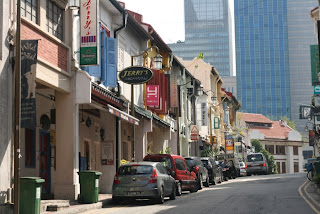Chinatown 新加坡
On May 18th, our third day in Singapore, the hot and humid weather didn't stop our visit to the Chinatown. Although there are two MRT stations adjacent to the area, but the trip underground would provide no scenery of the city at all. After carefully studying the map, we found out that the best way to get there from Orchard Road is by bus.
Since the traffic was quite low despite morning rush hour, the bus trip took less than half an hour down Orchard Road and North Bridge Street and cost less than S$2. We got off right across Hong Lim Park and immediately stood face-to-face to the district which preserves the rich history and culture of Chinese immigrants whose descendants now make up 70% of the population of the island-state.
(http://wikipedia.org provides the detailed info in the next section)
Singapore's Chinatown is an ethnic neighbourhood featuring distinctly Chinese cultural elements and a historically concentrated ethnic Chinese population. Chinatown is located within the larger district of Outram.
As the largest ethnic group in Singapore is Chinese, Chinatown is considerably less of an enclave than it once was. (Note: The name Chinatown (唐人街) is usually used by non-Chinese Singaporeans whereas Chinese Singaporeans usually use the term Niu Che Shui (牛车水) as the term Chinatown (唐人街) usually refers to enclaves of Chinese people in regions where Chinese people are the minority ethnic group.) However, the district does retain significant historical and cultural significance.
Singapore's Chinatown is composed of several precincts - Kreta Ayer, Telok Ayer, Tanjong Pagar, Bukit Pasoh and Ann Siang Hill.
Kreta Ayer - Kreta Ayer is considered by many to be the heart of Singapore's Chinatown. Housing attractions such as Chinatown Heritage Centre, Chinatown Food Street and Chinatown Night Market, Kreta Ayer is both a popular tourist destination as well as a favoured location for local food.
Telok Ayer - The original focal point of settlement in Chinatown, Telok Ayer is home to many Chinese temples as well as Muslim mosques that have been around since the first days of Chinatown. More recently, restaurants and drinking holes have begun popping up on Telok Ayer's streets.
Tanjong Pagar - Once the center of operations for rickshaw pullers, Tanjong Pagar today is known for the large number of bridal saloons that have set up shop along her rows of preserved pre-World War II shophouses. Singapore's tallest Housing and Development Board (HDB) flat, The Pinnacle@Duxton, also resides in Tanjong Pagar.
Bukit Pasoh - Known also as the "Street of Clans", Bukit Pasoh is the historic, and in many cases, current, home of several Chinese cultural and clan associations - unusual neighbours to the slew of boutique hotels and international restaurants that have sprung up.

The first street that we explored was Mosque Street, named after Jamae Mosque, located on the South Bridge Road end of the street. The mosque was completed in 1830 by the Chulia Muslims from the Coromandel coast of South India. In the early years, Mosque Street was the site of ten stables.
Right in the south bridge end of Pagoda Street stands the Sri Mariamman Temple. The street was formerly known as Almeida Street after Joaquim d'Almeida, son of José D'Almeida, who owned some land at the junction of Temple Street and Trengganu Street. In 1908, the Municipal Commissioners changed its name to Temple Street to avoid confusion with other streets in Singapore which were also named after D'Almeida.
Later we took a short trip via Ann Siang Hill, which was named after a wealthy Hokkien Chinese sawmiller who acquired the area to serve as his house and estate in the 1800's. Today, the slopes of Ann Siang Hill are filled with quirky shops, cafes and drinking holes, making it a popular hangout spot with the younger generation. In the other end of the street lies Ann Siang Park. Standing in the small park, we can see that tall buildings standing in the south making a great contrast between the old and new Singapore.
After a quick stop in a food corner for some refreshments, we found ourselves hovered by a huge red temple that housed the famous Buddha tooth relic. The temple welcomes devout buddish worshippers from all over the world.
Most shops are located on Trengganu Street, described as "the Piccadilly of Chinese Singapore" in the past. Now forming the heart of the tourist belt in Chinatown, it is called gu chia chui wah koi in Chinese, or "the cross street of Kreta Ayer". The crossing of streets refers to Smith Street and Sago streets. The street name is derived from Terengganu, a state in present day Peninsular Malaysia.
Most shops sell souvenirs for quite a bargain. The same keychains and t-shirts we bought in Bugis the day before were sold much cheaper here.
This place is much festive - as expected - during The Chinese New Year celebration with Paper lamps, banners, lights decorating the streets and barong say and liong performers showing off their acrobatic skill.


























Comments